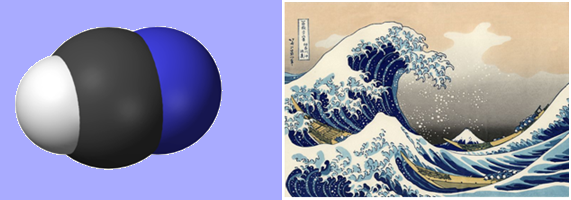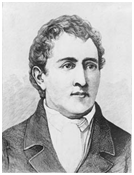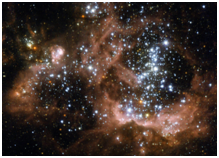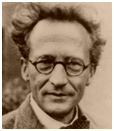![]()
Hydrogen Cyanide |
|
From Prussian Blue to Schrödinger's Cat |
![]()
Alberto Morón Hernández
King's College, Madrid, Spain
Molecule of the Month - November 2011
![]()
What do one of the best-known thought experiments in quantum mechanics, chemical weapons and a substance used as a tracer for a variety of astrochemical reactions have in common? A weakly acidic chemical compound known as hydrogen cyanide is responsible for suspending a cat between life and death, helps researchers trace astronomical processes and is found in fruits that have a pit, such as apricots, apples and bitter almonds.

Left: Spacefill image of the Hydrogen Cyanide molecule. Right: "The Great Wave off Kanagawa" by Hokusai, a famous piece of art which uses the pigment Prussian blue. Hydrogen cyanide was first isolated from this dye in 1783.
 History
HistoryPrussian blue is a dye which was synthesized for the first time by the paint maker Diesbach in Berlin around the year 1704. Pierre Macquer, a French chemist, converted the dye to iron oxide and a volatile compound in 1752; this was the first step towards the isolation of HCN. Thirty-one years after Macquer's find the Swedish chemist Carl Wilhelm Scheele isolated it from Prussian blue in its pure form. It was given its German name, Blausäure (blue acid), from its blue iron compound Fe7(CN)18, known as Berlin blue.
The Andrussow Process is a method of creating Hydrogen Cyanide on an industrial scale based on the oxidation of methane and ammonia at about 1200°C over a platinum catalyst. Leonid Andrussow discovered the process in 1927. The chemical reaction that describes the process is:
Fruits that have a pit, such as cherries, apricots, apples, and bitter almonds, all contain hydrogen cyanide. Many of these pits contain small amounts of cyanohydrins, which slowly release hydrogen cyanide; one hundred grams of crushed apple seeds can yield roughly about 10 mg of HCN. Up to one gram of hydrogen cyanide per kilogram may be obtained from the "bitter" roots of the cassava plant. Hydrogen cyanide has been considered as a precursor to certain amino acids and nucleic acids essential for the origin of life. However, there is still much speculation concerning the relationship of these reactions with HCN with the origin of life theory. Studies in this area have led to the discovery of links between these acids and organic compounds obtained from the condensation of hydrogen cyanide.
|

The interstellar cloud NGC 604. |
Another significant occurrence of hydrogen cyanide in Nature occurs in interstellar space. A number of mechanisms and reactions make the creation and eventual destruction of hydrogen cyanide in interstellar clouds possible. The way HCN is destroyed in clouds is determined by the cloud's position. Photodissociation and photodissociation by cosmic rays are the predominant mechanisms, producing HCN+ and HCNH+. Hydrogen cyanide is used to examine reactions and processes in space, and has been proposed as a tracer in regions of dense molecular gas.
 Wanted: Schrödinger's Cat. Dead and alive.
Wanted: Schrödinger's Cat. Dead and alive.Schrödinger's cat is a famous thought experiment that illustrates the principle of superposition, proposed by Erwin Schrödinger in 1935. Schrödinger's cat demonstrates the apparent conflict between what quantum theory tells us about the nature of matter on the microscopic level and what we observe to be true about its nature on the macroscopic level -- everything visible to the human eye.
Schrödinger's experiment says: We place a living cat into a steel chamber, along with a device containing a vial of hydrogen cyanide. We also place in the chamber a radioactive substance and a Geiger counter. There is a 50% chance that the substance will release radiation. If radiation is detected by the counter, the flask is shattered, releasing the poison that kills the cat.
This thought experiment serves to demonstrate many concepts in quantum mechanics such as superposition, which is related to the Schrödinger equation, or entanglement.
Although there is no confirmed information that would point towards hydrogen cyanide being used in chemical warfare, it is considered by the Organisation for the Prohibition of Chemical Weapons as a weapon. However, there are reports that it was employed by Iraq in the war against Iran and against the Kurds in northern Iraq during the 1980s. Hydrogen cyanide is a highly volatile liquid or colourless gas and in sufficient concentrations will rapidly lead to death. During the Second World War, a form of hydrogen cyanide (known as Zyklon B) was used in the Nazi gas chambers.
Hydrogen cyanide is highly toxic since it inhibits metal-containing enzymes. One such enzyme is cytochromoxidase, which contains iron. This enzyme system is responsible for providing energy to cells where oxygen is used, i.e., cell respiration. When cell respiration stops, normal cell functions are no longer maintained, which leads to mortality.
![]()
![]() Back to Molecule of the Month page. [DOI:10.6084/m9.figshare.5426596]
Back to Molecule of the Month page. [DOI:10.6084/m9.figshare.5426596]